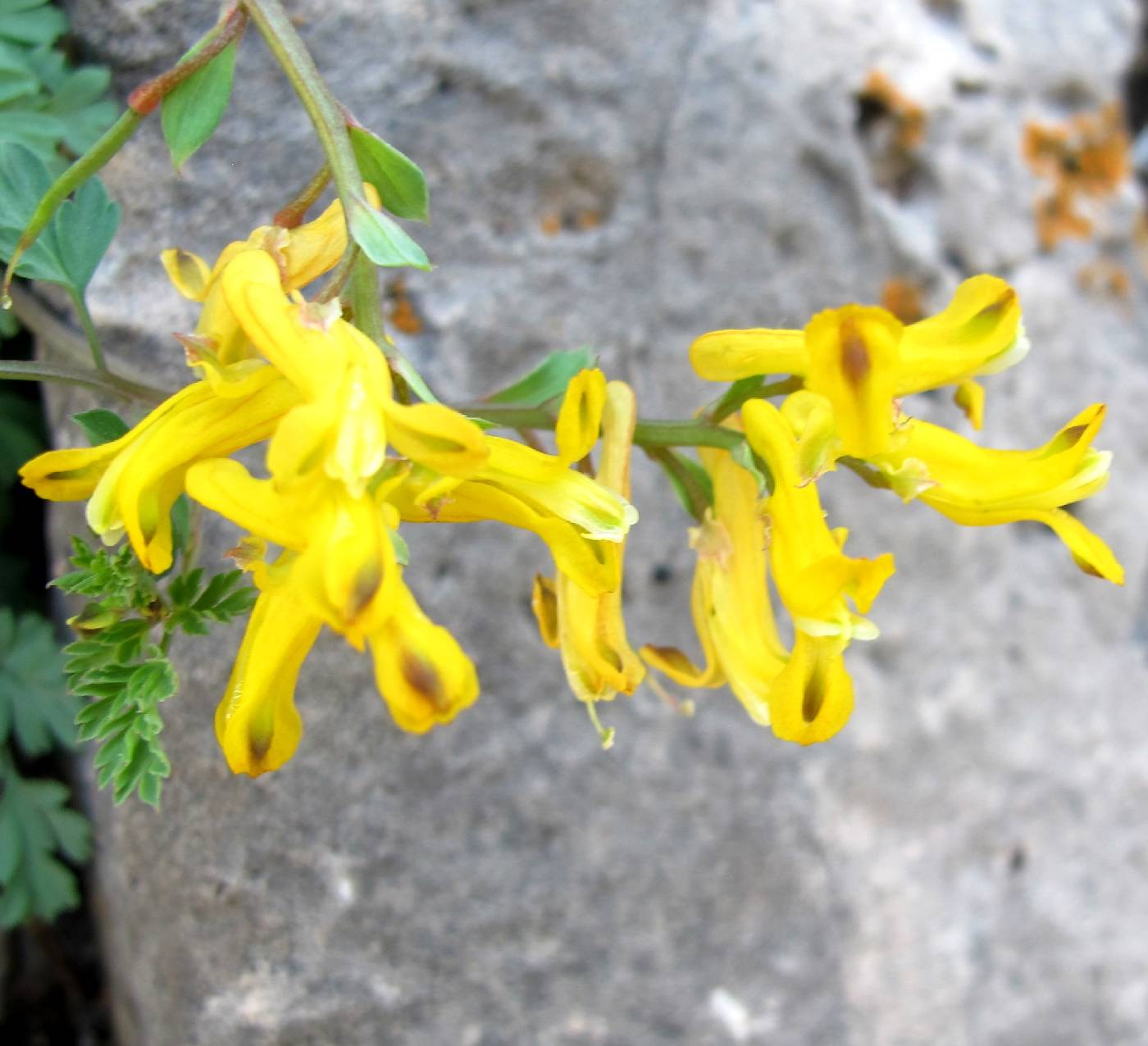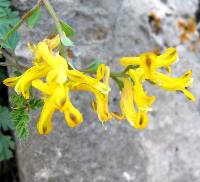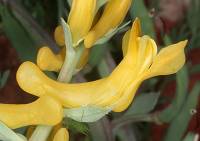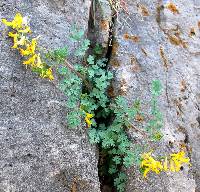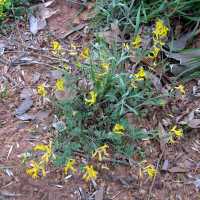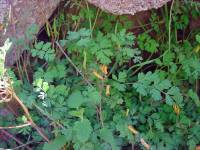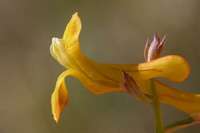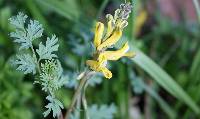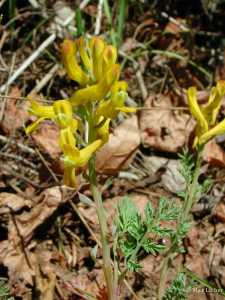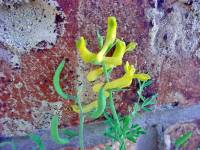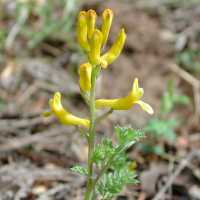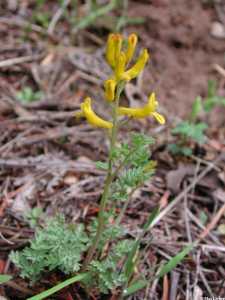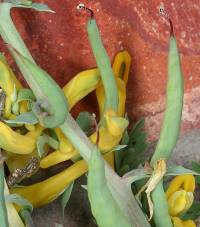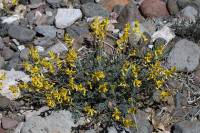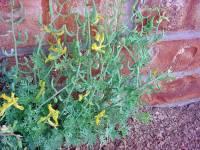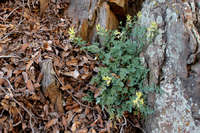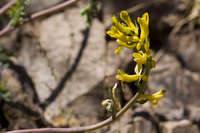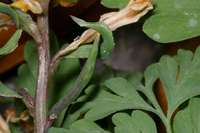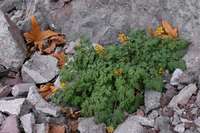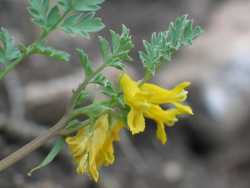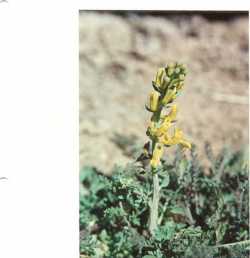Plants winter annual or biennial, glaucous, from ± branched caudices. Stems 10-50, prostrate-ascending, 2-3.5 dm. Leaves compound; blade with 3 orders of leaflets and lobes; ultimate lobes elliptic, 1.5 times or more longer than wide, margins incised, apex subapiculate. Inflorescences racemose, 10-20(-30)-flowered, primary racemes shorter than to slightly exceeding leaves, secondary racemes fewer flowered; bracts elliptic to linear, 4-10 × 1-2 mm, rarely larger, margins often denticulate toward apex, distal bracts usually much reduced. Flowers at first erect, later reflexed; pedicel 5-10 mm; sepals ovate to attenuate-ovate, to 1-3 mm, margins often sinuate or dentate; petals pale to bright yellow; spurred petal 13-16 mm, spur straight or slightly incurved, 4-5 mm, apex subglobose, crest low and incised or absent, marginal wing moderately to well developed, unspurred outer petal 9-11 mm, crest same as that of spurred petal; inner petals oblanceolate, 8-10 mm, blade wider than claw and more prominently winged toward apex, claw 3.5-4.5 mm; nectariferous spur 2-3 mm; style ca. 3 mm; stigma 2-lobed, 1/2 as long as wide, with 8 papillae. Capsules erect to pendent at maturity, linear, often torulose, slender to somewhat stout, straight to moderately incurved, 12-24(-30) mm. Seeds nearly 2 mm diam., appearing essentially smooth under magnification, narrow marginal ring present or absent.
The Navaho used Corydalis aurea medicinally for a variety of ailments, including rheumatism, diarrhea, sores on the hands, stomachaches, menstrual problems, and sore throats, and as a general disinfectant (D. E. Moerman 1986, no subspecies cited).
LEAVES: glaucous.
INFLORESCENCE: 8-20 flowered, included or exceeding the leaves.
FLOWERS: erect in bud, then spreading; pedicels 1-5 mm long; sepals 1-3 mm long; petals 14-18 mm long, yellow, the spurs 4-9 mm long; stamens ca. 5 mm long.
FRUITS: 12-24 mm long, usually curved, erect, spreading or pendant.
SEEDS: ca. 1 mm long, with or without marginal ring.
NOTES: 2 subsp. in AZ; AK to n. Mex., e to New England.
REFERENCES: Holiay, Susan, and Abril Perez. 2001. Commelinaceae. J. Ariz. - Nev. Acad. Sci. Volume 33(1).
Duration: Annual
Nativity: Native
Lifeform: Forb/Herb
General: Winter annual to biennial herb, to 50 cm tall, from a taproot; stems with watery juice, prostrate to ascending, simple to diffusely branching, glabrous and glaucous.
Leaves: Alternate along the stems and also in basal tufts, often on long petioles; blades glaucous, once or twice pinnately compound, with the ultimate leaflets often dissected into pinnatifid lobes.
Flowers: Yellow and showy, in 8-20 -flowered terminal racemes; flowers erect in bud, then spreading on pedicels 1-5 mm long; sepals yellow or whitish, 2 per flower, scale-like, 1-3 mm long, falling off early; petals yellow, 4 per flower, 14-18 mm long, the inner pair of petals enclosing the stigma and the outer pair spreading at the top, one of the outer petals with a spur at the base, this 4-9 mm long.
Fruits: Capsule linear, 12-24 mm long, usually curved and often constricted between the seeds.
Ecology: Found in loose, dry sandy soil, on hillsides, roadsides, washes, and moist riparian areas, from 2,500-11,000 ft (762-3353 m); flowers March-August.
Distribution: Most of N. Amer; most states in the US except for the southeast; south to c MEX.
Notes: A distinct biennial due to the golden, two lipped flowers with a spur at the base; spreading growth form; gray-green, glaucous, dissected leaves; and long narrow seed pods that resemble mustard seed pods. Two subspecies in the region: subsp. aurea and subsp. occidentalis. In subsp. aurea, the fruit is spreading or pendant and the inflorescences do not grow taller than the leaves. In subsp. occidentalis, the fruit is erect and the inflorescences grow taller than the leaves. The former ranges from 2,500-7,500 ft (762-2286 m) and is found in moist riparian areas. The latter is in loose dry soil and is found only from 2,500-4,000 ft (762-1219 m). Look for this species in the fumewort family, Fumariaceae, in older texts; recently that entire family was subsumed into the poppy family, Papaveraceae, based on molecular data.
Ethnobotany: Used to treat diarrhea, sores, stomachache, back pain, menstrual difficulties, and sore throat; also used as a disinfectant, a stimulant, and a rheumatic remedy.
Etymology: Corydalis is from the Greek word korudos, a crested lark, alluding to the shape of the flowers; aurea means gold, alluding to the flower color..
Synonyms: Capnoides aureum, Corydalis washingtoniana
Editor: SBuckley 2010, FSCoburn 2015, AHazelton 2017
Prostrate-ascending annual or biennial, 2-5 dm, the stems sympodial; racemes dense, 1-3 cm, often surpassed by the upper lvs; bracts lanceolate; sep broadly ovate, 1.5-2 mm, erose; cor bright yellow, 13-16 mm, incl. the 4-5 mm spur; outer pet folded distally along the median line into a conspicuous but wingless keel; fr smooth, spreading or drooping, 1.5-2.5 cm; seeds ca 2 mm wide, with a narrow ring-margin; 2n=16. Rocky banks or sandy soil; Que. to Alas., s. to Pa., Mich., n. Ill., and Minn., and widespread in w. U.S. May-July. Our plants are var. aurea; var. occidentalis Engelm., often attr. to our range (as C. montana Engelm.) is more southwestern.
Gleason, Henry A. & Cronquist, Arthur J. 1991. Manual of vascular plants of northeastern United States and adjacent Canada. lxxv + 910 pp.
©The New York Botanical Garden. All rights reserved. Used by permission.


